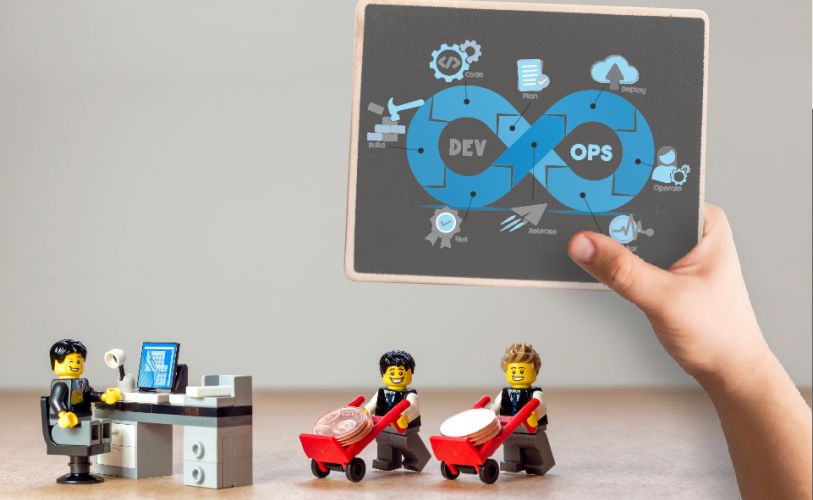

Brauchen wir DevOps?
DevOps ist eine Reihe von Operationen, die Softwareentwicklung und IT-Operationen umfassen, um Anwendungen schneller und zuverlässiger zu entwickeln, zu testen und freizugeben. Der Begriff DevOps wurde aus "Entwicklung" und "Betrieb" gebildet, um eine Brücke zwischen diesen beiden Teams zu schlagen. Die Kombination des DevOps-Modells mit agilen Methodologien wie SCRUM oder Kanban hilft Entwicklern und Betreibern, effizienter und innovativer zu sein und ihren Kunden und ihrem Unternehmen einen höheren Mehrwert zu bieten.
Der Begriff DevOps wurde zum ersten Mal auf der Konferenz DevOps days (2009) verwendet, die von dem belgischen Berater, Projektmanager und Agile-Praktiker Patrick Debois ins Leben gerufen wurde.Seitdem entwickelt sich die DevOps ständig weiter und schafft eine stärkere Verbindung zwischen den verschiedenen Teams im Unternehmen, wodurch bessere Ergebnisse im Anwendungslebenszyklus erzielt werden.
DevOps löst keine Werkzeugprobleme, sondern Probleme zwischen menschlicher Kommunikation, indem es Zusammenarbeit und Vertrauen fördert. Die häufigsten Probleme ohne Verwendung des DevOps-Modells sind:
- Mangel an einer soliden Produktmanagement-Strategie - Mangelndes Wissen über Kundenbedürfnisse, fehlende Funktionen und wettbewerbsfähige Preise führen zu schlechten Produktmanagementstrategien.
- Lange Zeit bis zur Markteinführung - Eine mangelhafte Koordination aller am Produktlebenszyklus beteiligten Teams führt zu einer ineffizienten und langsamen Produktion und damit zu einer langen Zeit bis zur Markteinführung.
- Niedrige Designqualität und Zuverlässigkeit - Ohne CI & CD, die die Grundelemente von DevOps sind, fehlt das entscheidende Feedback, das Wissen über die Produktleistung und -stabilität bringt.
DevOps-Zyklus

Der DevOps-Zyklus besteht aus 8 aufeinander folgenden Prozessschritten:
- Planen
- Codieren
- Bauen
- Testen
- Veröffentlichen
- Bereitstellen
- Betrieb
- Überwachung
Planung, Codierung und Bauen
Jede Produktentwicklung beginnt mit der Anforderungsanalyse, der Definition von Randbedingungen und Funktionen. Danach schreiben die Entwickler den Code und bauen das Produkt auf.
Verifizieren und Testen
Nachdem das Produkt gebaut wurde, muss das Qualitätssicherungsteam überprüfen, ob die Anforderungen wie spezifiziert umgesetzt wurden, und alle vorhandenen Fehler durch gründliches Testen des Builds finden.
Veröffentlichung, Bereitstellung und Konfiguration
Nachdem das Produkt erfolgreich verifiziert und getestet wurde, erfolgt die Veröffentlichung. Die Betreiber setzen das Produkt in der Produktionsumgebung ein und konfigurieren es.
Betrieb und Überwachung
Eingesetztes und konfiguriertes Produkt kann nun gestartet und betrieben werden. Eine kontinuierliche Überwachung wird ebenfalls durchgeführt.
Fazit
Durch den Einsatz von DevOps erreichen Sie eine bessere Zusammenarbeit zwischen Ihren Teams, eine schnellere Markteinführung und kürzere Vorlaufzeit zwischen den Korrekturen, eine höhere Bereitstellungsfrequenz, was alles zu einem qualitativ hochwertigen und zuverlässigen Produkt, aber vor allem zu zufriedenen Kunden führt.
Wenn Sie weitere Fragen haben oder einfach nur Hilfe bei der Analyse benötigen, um Ihre Entscheidung zu treffen, kontaktieren Sie uns bitte. Wir bieten Ihnen eine kostenlose Beratung an.